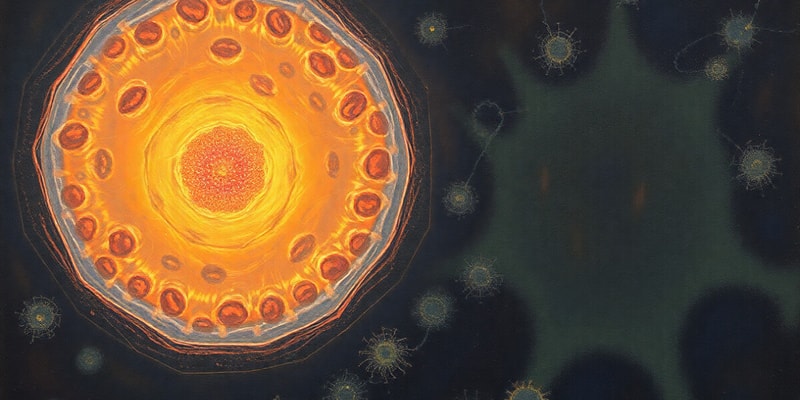Podcast Beta
Questions and Answers
What is the primary function of the Golgi apparatus in eukaryotic cells?
Which structure is responsible for maintaining turgor pressure in plant cells?
Which of the following cellular structures is involved in detoxification of hydrogen peroxide?
Which organelle is characterized by being the site of ATP production?
Signup and view all the answers
What distinguishes prokaryotic cells from eukaryotic cells?
Signup and view all the answers
Which component of the cytoskeleton is specifically involved in maintaining cell shape?
Signup and view all the answers
Cells communicate through signaling molecules that bind to specific structures. What are these structures called?
Signup and view all the answers
What feature of eukaryotic cells allows for the separation of processes like DNA replication and protein synthesis?
Signup and view all the answers
Study Notes
Cell Structure
Basic Units of Life
- Cells are the fundamental units of structure and function in living organisms.
- Two main types of cells: Prokaryotic and Eukaryotic.
Prokaryotic Cells
- Lack a nucleus and membrane-bound organelles.
- DNA is located in the nucleoid region.
- Typically smaller and simpler than eukaryotic cells.
- Examples: Bacteria and Archaea.
Eukaryotic Cells
- Have a nucleus and membrane-bound organelles.
- Generally larger and more complex.
- Examples: Animal cells, plant cells, fungal cells, and protists.
Key Organelles in Eukaryotic Cells
-
Nucleus
- Contains DNA; controls cell activities.
- Surrounded by a nuclear envelope.
-
Mitochondria
- Powerhouse of the cell; site of ATP (energy) production.
- Contains its own DNA.
-
Ribosomes
- Sites of protein synthesis.
- Can be free in the cytoplasm or bound to the endoplasmic reticulum.
-
Endoplasmic Reticulum (ER)
- Rough ER: Studded with ribosomes; involved in protein synthesis and processing.
- Smooth ER: Lacks ribosomes; involved in lipid synthesis and detoxification.
-
Golgi Apparatus
- Modifies, sorts, and packages proteins and lipids for secretion or delivery to other organelles.
-
Lysosomes
- Contain digestive enzymes; break down waste materials and cellular debris.
-
Peroxisomes
- Involved in fatty acid degradation and detoxification of hydrogen peroxide.
-
Cytoskeleton
- Network of fibers that helps maintain cell shape, aids in movement, and organizes organelles.
- Composed of microtubules, microfilaments, and intermediate filaments.
-
Plasma Membrane
- Semi-permeable barrier that separates the cell from its environment.
- Composed of a phospholipid bilayer with embedded proteins.
Plant Cell Specific Structures
- Cell Wall: Rigid outer layer that provides support and protection.
- Chloroplasts: Sites of photosynthesis; contain chlorophyll.
- Central Vacuole: Large, fluid-filled organelle that maintains turgor pressure and stores substances.
Cell Size and Shape
- Cells vary in size and shape according to their function (e.g., nerve cells, muscle cells).
- Surface area-to-volume ratio is important for efficient transport of materials.
Cellular Functions
- Cells perform various functions including metabolism, energy conversion, and reproduction (cell division).
Cell Communication
- Cells communicate through signaling molecules and receptors, coordinating activities and responses.
Basic Units of Life
- Cells serve as the essential structural and functional units of all living organisms.
- Two primary categories of cells: Prokaryotic and Eukaryotic.
Prokaryotic Cells
- Do not possess a nucleus or membrane-bound organelles.
- DNA is found in a region called the nucleoid.
- Generally smaller and less complex compared to eukaryotic cells.
- Common examples include Bacteria and Archaea.
Eukaryotic Cells
- Contain a nucleus and various membrane-bound organelles.
- Typically larger and exhibit greater complexity than prokaryotic cells.
- Include diverse types: animal cells, plant cells, fungal cells, and protists.
Key Organelles in Eukaryotic Cells
- Nucleus: Houses DNA and regulates cell functions, encased in a nuclear envelope.
- Mitochondria: Known as the cell's powerhouse, responsible for ATP production; contains its own DNA.
- Ribosomes: Responsible for protein synthesis, found either floating in the cytoplasm or attached to the endoplasmic reticulum.
-
Endoplasmic Reticulum (ER):
- Rough ER: Ribosome-studded, integral for protein synthesis and processing.
- Smooth ER: Lacks ribosomes, plays a role in lipid synthesis and detoxifying harmful substances.
- Golgi Apparatus: Modifies, sorts, and packages proteins and lipids for secretion or delivery to other organelles.
- Lysosomes: Contain enzymes for digesting waste materials and cellular debris.
- Peroxisomes: Specialized in breaking down fatty acids and detoxifying hydrogen peroxide.
- Cytoskeleton: A fibrous network providing structural support, cell movement, and organelle organization, composed of microtubules, microfilaments, and intermediate filaments.
- Plasma Membrane: A semi-permeable barrier that delineates the cell from its surroundings, structured as a phospholipid bilayer with proteins embedded.
Plant Cell Specific Structures
- Cell Wall: A robust outer layer for structural support and protection.
- Chloroplasts: Sites for photosynthesis, contain the green pigment chlorophyll.
- Central Vacuole: A prominent fluid-filled organelle essential for maintaining turgor pressure and storing nutrients.
Cell Size and Shape
- Cell morphology varies significantly based on function (e.g., neurons, muscle cells).
- The surface area-to-volume ratio is crucial for effective material transport.
Cellular Functions
- Cells execute various functions including metabolism, energy transformation, and reproduction through cell division.
Cell Communication
- Cells interact using signaling molecules and receptors to coordinate activities and respond to environmental changes.
Studying That Suits You
Use AI to generate personalized quizzes and flashcards to suit your learning preferences.
Description
Explore the fundamental units of life with this quiz on cell structure. Understand the differences between prokaryotic and eukaryotic cells, and learn about key organelles like the nucleus, mitochondria, and ribosomes. Test your knowledge on the basic units of life and their functions.



